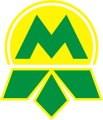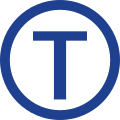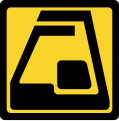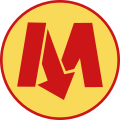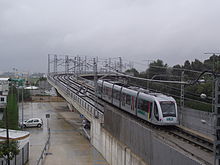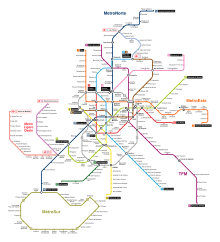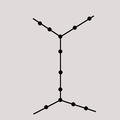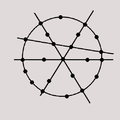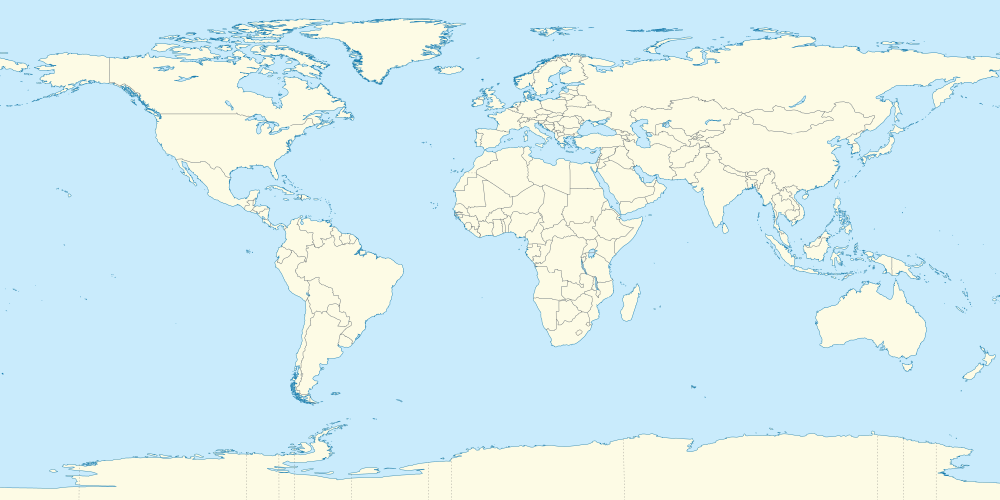Subway
Subway logo in Berlin
Subway logo in Hamburg
Subway logo in Munich
Subway logo in Nuremberg
Subway logo in Vienna
Metro sign in Paris
Underground logo in London
A subway or metro (short for subway , subway or metropolitan ) is usually an underground, rail-bound means of transport for urban public transport (ÖPNV, urban transport ).
The term is used for the entire system, a subway route and line and colloquially also for the individual vehicle (subway railcar , subway train ). While the »U« is actually an abbreviation for underground , in many subway networks there are also sections on the surface, in incisions , on embankments or elevated as an elevated railway . For this reason, the U is sometimes interpreted as "independent" in the German-speaking area - after all, it is a matter of rail transport systems that are independent and free of intersections and are designed to be independent of other urban transport systems.
Designations
The most widely used term internationally outside of German usage is Metro . This is likely to go back to the terms Metropolitan Railway in London (today Metropolitan Line ) and Chemin de fer métropolitain , Métro for short , in Paris . This name has also become common in Spain and Italy. Russian, Polish, and Hungarian also use the short form of this expression. Underground or Tube (London) are also used , in Scandinavian countries also T-Bana ( Tunnelbana ) or T-bane ( Oslo T-bane ). The subways in Manila , Singapore and Taipei are called MRT for Mass Rapid Transit , while in Hong Kong the abbreviation MTR is used for Mass Transit Railway . In North America, the term subway is common; in some largely aboveground systems also rapid transit . A few networks in North America are also called Metro or Metrorail , for example in Washington, DC , Los Angeles and Miami or in French-speaking Montreal . Abbreviations such as "BART" (San Francisco and surrounding area) or "MARTA" (Atlanta) are also used in everyday language. Finally, in Buenos Aires the subway is called Subte (from Subterráneo ). However, “Metro” is not always a generic term, but is protected as a trademark for metro operators in Spain and France in particular .
Métro logo in Algiers
Metro logo in Amsterdam
Metro logo in Ankara
Μετρό logo in Athens
Metro logo in Barcelona
Metro logo in Brussels
Metró logo in Budapest
Mетро logo in Kharkiv
Metro logo in Delhi
Mетро logo in Dnipro
Subway logo in Glasgow
Helsinki metro logo
Metro logo in Istanbul
Metro logo in Izmir
Metro logo in Cairo
Mетро logo in Kazan
Mетро logo in Kiev
Metro logo in Copenhagen
Métro logo in Lille
Metro logo in Lisbon
Underground logo in London
Métro logo in Lausanne
Métro logo in Lyon
Metro logo in Madrid
Metro logo in Mexico City
Mетро logo in Moscow
Mетро logo in Minsk
Mетро logo in Novosibirsk
Mетро logo in Nizhny Novgorod
T-bane logo in Oslo
Métro logo in Paris
Beijing subway logo
Metro logo in Porto
Metro logo in Prague
Métro logo in Rennes
Metro logo in Rio de Janeiro
Metro logo in Rotterdam
Mетро logo in Samara
Metro logo in Santo Domingo
Mетро logo in Saint Petersburg
Metro logo in São Paulo
Metro logo in Seoul
Metro logo in Seville
Metro logo in Sofia
T-bana logo in Stockholm
Metro logo in Sydney
Metro logo in Tehran
Metro logo in Tbilisi
Métro logo in Toulouse
Tyne and Wear Metro logo
Metro logo in Warsaw
Washington Metro logo
Definition and demarcation



The International Association for Public Transport (UITP) defines a metro as follows: “Metro railways are an urban , electrically operated passenger transport system that can be flexibly integrated into the respective local transport network, offers its service at high speed and high capacity and is independent of any other system Traffic and road users moved on their own tunnel, ground level or bridge routes ”. In contrast, there are trams, the main characteristics of which, according to the UITP publications, are being guided (mostly by rail lines) and a very high level of adaptability.
According to German ( § 4 para. 2 Personenbeförderungsgesetz ) and Austrian ( tram Regulation - StrabVO) are right subways, however, trams , if they mainly for passenger transport in the transport any mountain or cable cars are used and. The umbrella term tram is defined as a special type of railway that adapts to the nature of road traffic and has a special track structure. A subway is therefore considered a tram in the legal sense, even though, unlike this, it not only has a special, but in fact one that is completely independent of road traffic . It is operated in accordance with the ordinance on the construction and operation of trams (BOStrab).
The Association of German Transport Companies (VDV) defines an underground as a rail-bound and, based on the UITP, as a means of mass transport that is completely separate from individual transport and that forms a closed system . Their routes can be in tunnels, on dams and viaducts or in open terrain. In this case, independent also means that a subway usually does not have any level crossings with other means of rail transport and no level crossings. In the case of subways, the traction current is supplied via conductor rails arranged on the side of the track or via overhead lines .
There are underground networks according to the VDV definition in Germany in the cities of Berlin , Hamburg , Munich and Nuremberg , in Austria in Vienna and in Switzerland in Lausanne . None of these subway networks run exclusively underground. The Serfaus Dorfbahn , a driverless, rope-driven underground air-cushion railway is sometimes referred to as the “U-Bahn”, but this does not correspond to the VDV definition of the term.
In Frankfurt am Main there is a light rail system that is officially known as the U-Bahn. Since the independence of the route network is only given by the fact that all road crossings are signposted with St. Andrew's crosses and formally represent level crossings, whereby there are only a few restricted level crossings. The same applies to the urban / underground trains in Hanover, Cologne, Bonn, Stuttgart and in the Ruhr area. The cities of Bochum and Herne in the Ruhr area have the U35 subway line, which is almost completely separate from individual traffic, as it runs completely straight and, with the exception of the above-ground section along Universitätsstraße through Querenburg, in a completely intersection-free tunnel through Bochum and Herne. The above-ground section in Querenburg runs completely on its own railway body and has only three level crossings with road traffic, which are not signposted as level crossings for road traffic. The traffic lights are secured with driving signals and equipped with an effective priority circuit, which usually prevents operational stops in front of these intersections.
At the same time, the VDV conceptually differentiates the underground from the tram and the light rail , which at least in parts can have a route on public roads, in the area of which the road traffic regulations must be observed. The demarcation to the S-Bahn results in Germany primarily from its legal position as a full- line railway or railway , which, for example, can also have level crossings with other means of transport. In other countries, the boundaries between subways and railways are often fluid and there is no legal differentiation. The demarcation is based more on operational cohesion or the owner function, since subways - unlike railroads - are mostly in municipal ownership.
A subway has at least the following characteristics: It is operated without a level crossing with other means of transport, offers a dense timetable - cycle sequence in urban areas and is operated and controlled electrically.
There are also subway-like systems for transporting goods only, such as the subways used to carry mail in some cities. Mine railways and casemate railways have some things in common with underground railways, but in contrast to these, they are not primarily used for passenger transport .
story
Technical preconditions and milestones
starting point
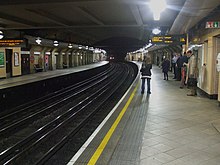
The subway as a means of transport, as it is used today in numerous cities, is the result of a long development that lasted through the entire second half of the 19th century. In the beginning there were plans for the inner-city, underground connection between long-distance railway terminus or other transport hubs - a task that today would more likely be assigned to an S-Bahn . Such plans existed in Vienna as early as 1844 . The first realizations took place from 1863 with the Metropolitan Railway in London and in 1869 in Athens with the Athens & Piraeus Railway Company . For the construction of tunnels for subways under high buildings, i.e. in cities, it was necessary to develop a technology in which the tunnel vault does not give way during construction. This could no longer be guaranteed by the pure wooden structures used to support the tunnel up to that point . Iron as a support material was first used in a pioneering project in the construction of the Naenser Tunnel .
Breakthrough thanks to electrical operation
The London tunnel route was driven by trains hauled by steam locomotives, which was not a permanently acceptable solution and therefore, apart from the Vienna light rail , was not copied in other cities. An important breakthrough in the development of underground urban transport was therefore the use of electric traction motors in rail transport. In Germany, the Berlin entrepreneur Werner Siemens did important pioneering work in this area . At the Berlin trade fair in 1879, Siemens presented an electric locomotive ; In 1881 he opened the world's first electric tram in Berlin-Lichterfelde . However, concerns and bureaucracy prevented Siemens from building an electric high-speed rail network in Berlin for decades, while the tube began to operate electrically with electric locomotives from the Manchester company Mather & Platt as early as 1890 , which was the most important prerequisite for the triumph of the new means of transport .
Elevated and subway
The second, initially unanswered, fundamental decision in the early years was the question of the layout of the high-speed rail lines: the London Underground mainly operated in tunnels in the inner city area . Projects in other European cities and in North America preferred the route on iron viaducts as an elevated railway . The majority of the metro lines built before the First World War ultimately emerged as elevated trains - the construction costs were well below those of a tunnel section, and especially in the districts of the lower class it was not seen as necessary to have to take the consequences of urban development into account. After the First World War, however, the tide turned; new routes have now been built almost exclusively in the tunnel. In North America, especially in New York , entire elevated railway lines were dismantled and replaced by tunnels. Instead of the overhead railway , the developed subway to the standard solution.
The first subways in London

The Metropolitan Railway, which opened in London on January 10, 1863, is generally considered to be the first underground railway in the world . However, it was initially a railway line operated by steam locomotives . It was intended as a connection line between the mainline stations Paddington , King's Cross , St Pancras and Euston , which were all relatively far outside the city center, and the City of London .
The first electric subway, which thus corresponds to today's ideas, was the City and South London Railway (now Northern Line ), opened on November 4, 1890 in London . It led from Stockwell to King William Street . Thus, London triggered an underground boom, because at the same time many other European metropolises were looking for ways to solve their inner-city traffic problems. It was believed that the subway concept could solve all these problems.
Early underground and elevated railways in Europe
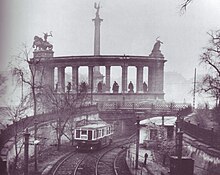

The first electric Metropolitan Britain outside London was completely above ground as elevated train circulating Liverpool overhead , which as well as the Athens metro was opened as a link between the city center and the sea port on February 4 1,893th The elevated railway in Liverpool received a one-time tunnel station when it was expanded in December 1896. However, the entire line was closed on December 30, 1956. In addition to the first underground passenger railway operated by the Athens & Piraeus Railway Company on mainland Europe, there was another in Istanbul . 1875 was Tünel - funicular opened in the European part of the city.
The first electric underground and regular service metro on mainland Europe was opened on May 2, 1896 in Pest , the eastern part of Budapest . This line, known today as the Millennium U-Bahn , was created on the initiative of the inventor Werner von Siemens and was originally planned for Berlin. However, since the local authorities could not come to an agreement there, Siemens had the Budapest subway built as a demonstration object for other European subway routes. Before that, however, Siemens competitor AEG had built an underground test route with a 295 m long and 3.15 m high tunnel on its Berlin factory site in 1895. AEG also initiated a second 454 m long underground tunnel for rehearsals and presentations, the Spreetunnel . He was a consortium of companies from 1895 through shield tunneling ( " tunneling shield "), a procedure that in 1870 the construction of the London Tower Metropolitan of the first deep-leveled Metro in the world for passing under the River Thames , was applied under the Spree at that time between the The Berlin suburbs of Stralau and Treptow were built and completed in 1899. Since the AEG did not receive a permit to build a metro in Berlin, it was not used as originally planned for a subway route, but from December 1899 onwards for a tram line operated by the Berliner Ostbahnen GmbH .
In the same year as the Hungarian Földalatti , the Glasgow Subway went into operation as the fourth rapid transit system. The line was first used as a cable car from December 14, 1896 and electrified only in 1935. Something similar happened with the Viennese steam light rail, opened in 1898 , from which the Viennese electric light rail emerged in 1925 .
In 1900, Paris followed with the Métropolitain (which was electrically operated from the start) . In just a few years, a network of numerous lines was built here. Even today, the Paris metro system carries a large part of the traffic flows in the French capital.
The single- rail suspension system Eugen Langen , better known today as the Wuppertal suspension railway , opened in 1901 in the neighboring West German cities of Barmen and Elberfeld , was a special form of elevated railway: the trains do not run on rails, but hang under the track. The viaduct construction turned out to be more complex than with a conventional elevated railway, because the carrier frames have to reach over the trains. The suspension railway is the first light rail in what is now Germany's federal territory.
After long discussions, a regular metro line was finally opened in Berlin on February 15, 1902 between Stralauer Thor - Potsdamer Platz (old train station) and the Zoological Garden . Werner von Siemens, however, did not live to see his late victory over the Berlin building bureaucracy; he had died in 1892. The electrical elevated and underground railway operated by Siemens & Halske mostly ran on a viaduct. However, later expansions through the city center and wealthy residential areas were built underground. The term U-Bahn also comes from Berlin , it was introduced in 1929 after the Deutsche Reichsbahn (1920–1945) had introduced the catchy abbreviation S-Bahn for its city, ring and suburban railways .
In 1904 the Athens – Pireás line, which was previously used by steam-hauled trains and was built in 1869, was electrified for what would later become the Athens subway and used exclusively for local transport.
But Siemens had not only put forward his idea of an electric rapid transit system in Berlin and Budapest; he had also planned a network for the Hanseatic city of Hamburg . Their first route was opened to the public exactly ten years after Berlin, on February 15, 1912. The company was called Hamburger Hochbahn AG , as most of the routes were built on viaducts and dams.
After the same difficulties with the Spanish authorities as in other European cities, the first metro lines were opened in Madrid (1919) and Barcelona (1924).
The pioneering companies in America

But the first subway networks were not only flourishing in Europe, the idea of the independent high-speed train gradually gained acceptance in North America as well . The first system, a purely elevated railway, opened in Chicago in 1892 as Chicago & South Side Rapid Transit , with electrification following three years later. The second system went into operation in Boston in 1897 . The first section of the tunnel was used for tram traffic, as it was rediscovered 70 years later (as the "Stadtbahn") in numerous cities. The residents of Boston are still very proud of this relatively early opening date, since it was not until 1904 that the most famous American city, New York , opened a subway called the “ Subway ”. The last of the old east coast metropolises, Philadelphia , followed in 1907.
In 1913, the subway line in Buenos Aires, Argentina, went into operation, which today bears the line designation A. This first South American subway is still operated today with trains from the early days. Buenos Aires now has six lines in operation with a total length of more than 40 kilometers.
Underground railways for freight transport
There were no limits to the creativity of the designers. After electrical operation and the growing experience in tunneling encouraged many cities to plan subway networks, it made sense to use the new technology for inner-city freight transport as well. The two systems implemented were, however, not so much a further development of conventional freight transport on the railroad than pneumatic tube technology .
The world's first pneumatic tube system, the Pneumatic Despatch Railway , went into operation in London in 1859. As a result, such underground networks emerged in a few dozen European and some non-European cities. In 1940 the Berlin network was around 400 kilometers long and served 79 post and telegraph offices. The mail items were transported in sealed capsules, using compressed air to drive them. The capacity of these plants was low. In Berlin, letters were allowed to weigh a maximum of 20 grams, in Munich 100 grams, and the network in New York could at least transport parcels. For the inner-city distribution of heavier goods underground, it was necessary to fall back on wheel-rail technology , and the underground railways for passenger transport had created the basis for this.
In Chicago, the construction of such an underground network began in 1899, the Chicago Tunnel Company Railroad , which was completed in 1906 and had tunnel routes under almost every street in the city center. The network reached a maximum length of 97 kilometers, with 149 locomotives and 3,000 freight wagons , loads and coal were transported from rail freight yards to department stores, offices and warehouses in the city center, and ashes were carried away from there. The emerging truck traffic and the switch from coal to gas heating caused sales to collapse in the 1940s, and the operator had to file for bankruptcy in 1956 . The network was shut down in 1959. However, the tunnels are still used today for laying power and telephone lines.
Based on the system in Chicago, the London Post Office Railway (also Mail Rail ) was built in London in 1927 . This small subway network connected eight post offices. The tunnels are up to 21 meters below street level. The 10.5 kilometer route ran from the mail sorting office at Paddington Station in a west-east direction to the district post office in the eastern part of Whitechapel. As five of the affiliated post offices closed over time, the facility was shut down in 2003. Further examples are the Post-U-Bahn in Munich from 1910 to 1988 (450 meters) and the one in Zurich from 1938 to 1981.
Also casemates tracks and pit trains can be designated as goods-U-webs, and this may also be used for transporting people.
Subway construction between the world wars

With the beginning of the First World War, the first phase of underground construction in the metropolises of the western world ended. The essential system questions were answered. The subway had prevailed against the elevated railway. The vehicles of the oldest systems had proven to be too small, and people switched to larger tunnel profiles and trains with larger capacities. The escalator was developed to be practical and enabled large numbers of passengers to be transported between deep tunnel stations and the surface of the earth. The underground system was fully developed in all essential areas and has been used largely unchanged to this day.
Between the world wars, only three networks went into operation in Europe: one in 1919 in the Spanish capital Madrid and a little later, in 1924, one in Barcelona . The third network was created in Moscow . The first underground rapid transit railway went into operation there in 1935. A commission of experts had previously been sent to Berlin to assess the system and gain experience. Moscow is best known for its very low-lying and magnificently decorated train stations. The then Soviet leader Stalin wanted the subway stations to be seen as "palaces of the working class".
The networks that already existed before the World War were expanded, in some cases as completely new systems incompatible with the older lines, in order to enable the use of larger vehicles.
The first Asian subway went into operation in the Japanese capital Tokyo in 1927. The Ginza Line between Asakusa and Ueno was the first section of the local subway. In 1933 the Japanese metropolis Osaka followed with the Midosuji Line.
The development of the post-war period
Mass motorization and transport policy
During and after the Second World War , underground construction stagnated almost everywhere. After 1945 the number of motor vehicles increased rapidly in the cities of the western world , the growing prosperity ensured the mass motorization .
In order to cope with the increasing road traffic, it was considered modern in many cities to shut down the local tram networks, since the tram was viewed as a significant hindrance to motorized individual traffic. As a result, all trams disappeared from the cityscape in London, Paris, West Berlin and Hamburg, among others.
Construction work in the area of the subway networks also largely came to a standstill. In many metropolises, such as Paris, not a single new route has been opened for decades. Exceptions were partly politically motivated, such as in West Berlin , which wanted to become independent from the Deutsche Reichsbahn and its S-Bahn network , or in Moscow , which was developed into the representative capital of the Soviet Union, which had become a world power.
Underground tram and light rail



In places where there was still no subway, the idea often came up of moving tram lines underground in sections in order to create more space for road traffic on the surface, to accelerate public transport and to handle it more smoothly, as well as the remaining tram network in the medium term to be able to give up. This solution was mainly used in German-speaking countries (Cologne, Stuttgart, Frankfurt am Main) and in Belgium.
A distinction must be made between two different basic concepts. In the simpler variant, a section of the tram route is laid underground, but otherwise operated as before, as in Boston in 1897 . These systems, known as underground trams , have, for example, underground track triangles and narrow arc radii.
The more elaborate light rail concept , on the other hand, provides for tunnels in the inner city areas, which in terms of curve radii, freedom from crossings and train protection are in part identical to the systems of classic underground trains, but which use existing tram routes in the outskirts. The basic idea was that a completed tunnel section could be integrated immediately into the existing tram network, instead of being a foreign body in the transport network like a short “classic” underground route for many years.
However, this short-term advantage was bought at the cost of certain disadvantages, including the intersections (in some cases even shared lane use) with road traffic and the associated susceptibility to interference.
The first tram tunnels were opened in Vienna and Stuttgart in 1966, and other cities were added in quick succession ( Essen 1967, Frankfurt and Cologne 1968, Brussels 1969, Bielefeld 1971, Antwerp , Hanover and Bonn 1975, Bochum 1979, Düsseldorf 1981, Charleroi and Dortmund 1983 , Zurich 1986, Duisburg , 1992).
Medium-sized western German cities such as Kassel and Ludwigshafen also built underground tram stations.
Some cities, such as Cologne or Stuttgart, which initially relied on the cheaper solution of the underground tram, subsequently changed their plans and developed them further into (more efficient) light rail operations.
Some light rail networks tend to develop in the direction of metro standards as they expand. There has been a “real” subway line in Frankfurt am Main since 1980. In Essen, Bochum and Dortmund there are light rail lines that have almost no crossings with road traffic. In Brussels, two light rail tunnels were converted to busbar operation after they had reached a reasonable length for traffic and have been operated with metro vehicles ever since.
New installations of "classic" subway networks
The light rail concept was only able to establish itself in North America in the 1980s ( light rail , also known as Metrorail), although in most cases there were no tunnels. Most of the new high-speed rail networks outside of Europe were therefore built as a classic metro system, for example in Cleveland , Montreal , Toronto and Nagoya .
In the 1950s, the so-called Métro sur pneumatiques (subway on rubber tires) was introduced. This was tested for the first time from 1954 on a test route of the Paris Métro , where a first line was equipped with it in 1959 . This system, which still maintains the wheel-rail technology, is particularly characterized by good braking and starting acceleration. Among other things, around half of the metro lines in Paris, the networks in Marseille, Lyon, Lille, Montréal, Mexico City, Santiago de Chile and Sapporo (Sapporo Metro ) use rubber-tyred trains today . On the M2 line of the Métro Lausanne , pneumatic tires with their higher static friction values were used , precisely because of the steep gradients of the route .
Unusual is from Leitschienenbahnen existing network of Japanese city of Sapporo . First in Canada , later also in Japan and China, lines were built whose vehicles run with linear drives .
Two new subway networks were also built in Germany, the first in Munich . Originally, an underground tram network was also planned in the Bavarian capital. But later the concept was revised and rescheduled to a full subway. The opening, initially planned for 1974, was brought forward to 1971 due to the 1972 Olympic Games .
The fourth and youngest German underground network went into operation in 1972 in Nuremberg . A light rail network was originally planned there as well. A special feature was that the subway vehicles from Munich and Nuremberg used to be identical and therefore basically interchangeable, so the two cities could help each other out in the event of bottlenecks. With the procurement of new generations of vehicles, the modernization of train control technology and the partially automatic operation, compatibility no longer exists. Since June 15, 2008, the U3 line in Nuremberg has been operated as the first fully automatic underground line in Germany to run on the trains without a driver - on the shared section with the U2 until the end of 2009 with its conventionally controlled trains in mixed operation, since then The U2 trains also run fully automatically.
Train of Series A of the Munich Underground
Fully automatic train of the type DT3 of the Nuremberg subway
Guardrail : Train on the Namboku Line of the Sapporo Subway
Metros based on the Soviet model
Since the 1960s, numerous new subway companies have been founded in the Soviet Union and other Comecon countries. New metro cities were, for example, Leningrad (1955), Kiev (1960), Tbilisi (1966), Baku (1967), Prague (1974), Kharkiv (1975), Tashkent (1977), Yerevan (1981), Minsk (1984), Nizhny Novgorod (1985), Samara (1987), Dnipropetrovsk (1995), Warsaw (1995), Sofia (1998), Kazan (2005) and Almaty (2011). In Budapest , two modern lines were built in addition to the line opened in 1896, the first section opened in 1970. There are also underground trams , for example the Metrotram Volgograd or the Metrotram Krywyj Rih .
The technical basics, the vehicles and even the network design were relatively uniform. In most cities, a secant network with three lines was designed. Line tunnels and train stations are sometimes very deep below street level, while long escalators connect the street and the platform. The distance between individual stations is greater than in the other European networks of the same period, which increases the average speed, but still requires tram, trolleybus or omnibus lines to develop the districts more precisely. Unlike in western cities, however, there were no large cities in socialist Europe that did without their trams.
The digital stopwatches at the front end of the platform are also typical of metros based on the Soviet model . These matrix displays show in minutes and seconds the time that has passed since the departure of the last train and reset to zero as soon as the next train leaves. As a result, passengers can, provided they know the clock sequence valid at the respective time of day and the operation is on time, estimate when the next possibility is available.
Current trends
New buildings and extensions
Created new metro networks and are planned in the industrialized countries of East Asia, and also in mega-cities of the so-called emerging countries such as the Mexico City Metro , Metrô São Paulo , Metrô Rio de Janeiro , Cairo Metro , Tehran Metro , Delhi Metro , Metro Caracas and Bangkok Metro .
Since the late 1980s, the number of new openings has decreased, particularly due to the high construction costs for tunnel sections. On other continents, existing networks are being expanded, but hardly any new ones are being built. Exceptions are the Spanish capital Madrid and the CIS countries , although in the latter, due to the financial shortage since the 1980s, work is still being carried out on unfinished networks, such as the Chelyabinsk metro or the Donetsk metro . This is why the railway industry has geared itself towards the construction of more cost-effective “light metros”, while conventionally designed underground railways (“heavy metros”) are currently in little demand.
The first subway, the Sydney Metro , has also been operating in Australia since 2019 . It took over some suburban railway lines and uses a new tunnel line in the city center in order to relieve the previous city center lines.
VAL metros
After France was already regarded as an innovation location for underground trains with its rubber-wheel drive in the 1950s, a highly automated rail system was tested and successfully implemented in the 1980s with the VAL system ( Véhicule automatique léger ). With numerous standardized components, it is more cost-effective to build than subways with a conventional concept. The new Métro Lille was the first to be built using this system, in a metropolitan area with only around one million inhabitants. This showed that even medium-sized cities can operate a profitable and efficient subway network. Other locations followed this concept, for example with the Métro Toulouse from 1993, the Metro Taipei since 1996, the Métro Rennes since 2002 and the Metropolitana di Torino since 2006.
VAL metros are also used for internal passenger transport at several major airports, for example in Atlanta , Paris-Charles-de-Gaulle ( CDGVAL ), Paris-Orly ( Orlyval ) and Chicago .
Low-floor metros
Underground and light rail vehicles were traditionally designed as high-floor transport systems, with elevated platforms allowing barrier-free access to high-floor vehicles. This was necessary in the past - and therefore designed in this way in all four German subway networks, Berlin, Hamburg, Munich and Nuremberg - because it was technically not possible to accommodate engines and electrical systems in a low-floor vehicle. The advantage, however, are wagons with a level wagon floor that is completely free of any necessary fixtures. While trams were usually not designed for barrier-free access and did not require complex structures at the stops, it quickly became clear that the price for barrier-free operation is very high, as the construction of above-ground stations is also a major cost factor here. Because elevated platforms are not feasible in many places due to urban planning conditions, it was often necessary to lay sections of the route in tunnels where this would otherwise not be necessary due to the volume of traffic.
In the 1990s, the first low-floor vehicles came onto the market, which also enable barrier-free entry into trams. Since then, such cars have also been delivered to newly opened metro operations, including those in the Spanish cities of Seville and Málaga . The U6 line of the Vienna subway is also served by low-floor trams ( type T ).
Routing and operation
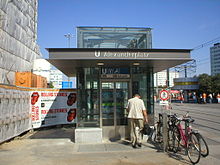
While in the cities of birth of the underground, London and Paris , the first lines were built underground from the start, in other cities they were often built as elevated railways on viaducts before tunnels were increasingly added to the course, such as in Liverpool , Chicago , Berlin , Hamburg , Vienna and New York . This was mainly due to the fact that the designers had no experience of tunneling under difficult conditions. But even today there are cities that, because of the muddy subsoil, have only a few metro trains that are very expensive to implement. The problem is the static buoyancy of the hollow, air-filled tunnels. There is also a risk of streets and buildings sinking. This is why there are few metro lines in cities with high groundwater levels such as Glasgow , Amsterdam and Saint Petersburg . The underground construction is in rocky ground, such. B. in Stockholm, however, relatively easy to implement.
The main advantage of the underground is the independence of the route by moving it to another level. By avoiding both intersections with streets and with tracks running in the street space, disruptions to operations can be reduced to a minimum. In this way, as is often the case in the meantime, fully automatic operation is possible. There are now fully automated metro routes in Paris , Lyon , Rennes , Lausanne and Copenhagen . The first attempts with fully automated operation in Germany were made in Berlin , Hamburg and Frankfurt am Main . The first fully automatic underground in Germany in normal operation was the U3 in Nuremberg , which opened on June 14, 2008. It ran - unique in the world - until 2009 on a section of the route in mixed operation with conventional trains. Since the beginning of 2010, line U2 has also been switched to fully automatic operation, so there is no longer any mixed operation.
Underground trains are usually characterized by a dense cycle sequence. However, the time advantage is lost on short stretches of deep-lying stations on the way to the underground train station. Likewise, people with disabilities, especially with older systems, are often difficult to use or not at all possible. The underground stations are only gradually being equipped with elevators for the disabled . The Berliner Verkehrsbetriebe, for example, has drawn up a calculation that the installation of an elevator costs roughly the same as the renovation of a complete train station. The Nuremberg subway is one of the few systems that can now be reached completely barrier-free. In general, an elevator has always been included in new buildings since the late 1980s.
After the S-Bahn, the underground trains are the most efficient mode of transport in the urban transport network. 35,000 to 40,000 passengers per hour can be transported in each direction (S-Bahn: 40,000 to 50,000; for comparison, cars with an assumed occupancy of 1.3: 2,500 people per hour and lane).
In order to reduce the tunnel cross-section, the energy is often supplied by a power rail located between or next to the rails . On the other hand, in some subway systems, especially in southern Europe, the trains have pantographs on the roof. There are also numerous special forms, all kinds of power systems and supply options. In some cities, for example, a second busbar is used to prevent stray current corrosion . There are also different versions of the busbars themselves. The most widespread way is to paint the pantograph from below. In the case of the Berlin Kleinprofil, in London and in many Japanese networks, this happens from above, which, however, represents a greater security risk. The lines built in Budapest after the Second World War are an example of busbars painted from above, which are nevertheless largely covered. The development of overhead conductor rails , however, significantly reduced the installation space for contact lines, especially since operation with them offers the advantage that the tunnels can be entered safely.
In the meantime, a range of 600 to 900 volts DC has become established for the operating voltage , regardless of whether the power is supplied via busbars or overhead lines. In Berlin, for example, a voltage of 750 volts is used, in all cities of the former Soviet Union with 825 volts. The fact that the electrical voltage of subway systems is generally somewhat higher than that of trams could be due to historical reasons, since the subway systems introduced later than the trams were each able to access a more highly developed standard of power supply and electric motor technology.
Route network
Historical network formation
There are various types of networks in the numerous underground systems around the world. The first subway networks consisted of radius lines that ended in the city center, or diameter lines that crossed them. In contrast, the ring networks , for example, were mostly created on ring roads running in the same direction. A further development is the ring radial network. The secant networks are very typical for metro systems in cities in former real socialist countries such as Kiev or Prague . These types of networks are still being planned and built despite the collapse of the Soviet Union. Meshed networks are mostly created under an existing road network, for example in New York or Paris . Understandably, some route networks deviate from these ideal types or are mixed types.
Ring line (e.g. Glasgow )
Diameter line with branches (e.g. Oslo , San Francisco Bay Area )
Ring radial network (e.g. Moscow )
Network structure and line purity
A characteristic of numerous subway networks is a pure line operation, which means that a subway route is only served by one line. The main reason for this is that pure line operation causes less effort in terms of technical security than a route with branch lines. In contrast to the S-Bahn or tram, subway networks are therefore usually designed in such a way that the transition of a vehicle between routes between two different lines in normal passenger operation is usually not or only when using track connections that are not intended for passenger operation (e.g. B. sweeping tracks ) is possible. The purity of the lines means that the routing of an underground line remains in place for a long time and only changes when the route is extended at a later date. Reconnecting branches, such as in the case of suburban trains or trams, usually involves extensive structural changes in the subway network. On this point, S-Bahn and trams allow more flexibility.
However, smaller subway systems in particular are not consistently straight-line. These are mostly routes that split into two branches out of town, such as in Stockholm , Copenhagen , Brussels , Munich or Bilbao . As a rule, the cycles of the branch lines are superimposed by means of timetable coordination and thus allow a closer train sequence on the jointly served section. This is mostly based on the knowledge that the dense cycle sequence required in the city center is inappropriately high for the routes to be served outside the city center. Here the advantages of a branched network and a correspondingly higher number of passengers outweigh the disadvantages of the increased technical security. However, even in New York and London, very large networks are not operated on a single line.
safety
In principle, the same safety devices are necessary for underground trains as for all rail vehicles with passenger transport. Compared to the railways, however, the areas of risk are shifted. In the case of railways, the main risks are when traveling at high speeds on an open track. In contrast, the dangers of the subway are far more likely to occur in the "platform situation", with the rush of crowds at peak times with its intensive passenger changes playing a role. The predominant implementation in tunnels means that standing still on the "open" route becomes a special risk area due to the tight confinement of the tunnel, especially if the train is also exposed to additional hazards, such as the fire in operating facilities. The narrow tube tunnels in London, in which it is not possible to exit a train at the sides, are particularly tricky. In addition, subways and their stations, with their easy accessibility and the temporally and spatially short stopping distances in metropolitan areas, offer much more than the railroad a field for criminal processes, especially in times with low passenger traffic, both on the platforms and in the vehicles.
Doors and passenger change

Since the opening of the London Underground as the first underground rapid transit railway, many measures have been introduced to ensure the highest possible level of safety for passengers. In addition to the departure announcement, the standard of today's subway system also includes a departure signal that is also understandable for foreign passengers. Visual departure signals, which are particularly intended for the deaf, have only been retrofitted for a few years, while in other places they have already been available from the beginning.
A fatal accident in Munich and a very similar incident with an injured person in Nuremberg have led to greater attention being paid to the sensitivity of the door locking mechanism. The drivers did not notice people trapped in the doors. The technical facilities that were supposed to prevent shutdown in such situations did not respond either. For example, the door edges of new trains on the Munich subway are fitted with pressure-sensitive sensors, and existing vehicles have been retrofitted. Likewise, the newly delivered DT3 trains in Nuremberg are delivered with correspondingly sensitive rubber door seals and the types DT2 and DT1 trains that are already in service (with the exception of the DT1, which are due to be retired) have been retrofitted with the same rubber door seals and with visual door closing warnings.
Another safety risk is the gap between the car and the edge of the platform, which in some cases is up to fifty centimeters wide; this is especially the case with platforms that are tightly curved. Not insurmountable in itself, the risk arises from the time pressure when boarding and alighting as well as the confusion when there is a large number of passengers. Solutions for this are, for example, the famous “Mind the Gap” in London, which is illustrated by announcements and lettering on the platform floor through to billboards with the words “The Gap kills!”. An alternative is the installation of additional sliding steps, as they are available on the DT3 trains in Nuremberg.
Dangerous situations can also result from the presence of a person on the tracks . They force the driver to apply the brakes quickly, which in certain circumstances can no longer prevent an accident. In order to counteract this, platform screen doors were installed mainly in Asian cities, on the driverless lines of the Métro Paris and, since 1999, also on new lines of the London Underground . These open synchronously with the train doors and can thus prevent an unintentional "falling onto the rails" in front of the train. Alternatively, electronic sensor systems have been installed on the driverless trains at the elevated railway stations in Copenhagen, which are intended to automatically detect dangerous situations and, if necessary, trigger emergency braking. In Nuremberg, microwave barriers were installed in the train stations on the lines intended for driverless operation (U2 and U3). These are located under the edge of the platform and on the opposite wall and are intended to detect objects and people from 20 to 30 centimeters tall falling into the track area and to initiate emergency braking of approaching driverless trains. The fully automated operation began on June 14, 2008 with some delays.
The tram construction and operating regulations applicable to underground trains in Germany state in Section 31:
- (4) As far as operational conditions require, stops must be marked with
- Facilities for information and handling of passengers,
- Systems for monitoring the change of passengers,
- Emergency call facilities,
- Fire extinguishing systems, fire water supply,
- Means and facilities for first aid.
- (...)
- (7) The horizontal distance between the platform edge and the vehicle floor or steps must be as small as possible; in the worst case, it must not exceed 25 centimeters in the middle of the door.
- (8) The heights of platform surfaces, vehicle floor and vehicle steps must be coordinated so that passengers can get on and off comfortably. The platform surface should not be higher than the vehicle floor in its lowest position; it must be slip-resistant.
- (9) At the platform boundaries, the risk of people falling must be prevented. Platform edges must be clearly recognizable.
Protection against destruction and threats
Due to the need to save money and rationalization measures by many transport companies, there are now for the most part neither the train attendants nor the supervisors who handled the trains at the stations and carried out general supervision. Their function was largely taken over by surveillance with cameras. For the general safety of the passengers, for example, safety telephones were set up in Berlin and Hamburg, which enable a direct voice connection to the control and information center. In London, every stop is still manned by several employees who coordinate operations, make announcements and dispatch the trains.
Due to the scratching and graffiti that have become fashionable in the last few decades , the vehicles are sometimes hardly recognizable (see also: Bahnfrevel ). In many metro cities, constant camera surveillance is also installed in the vehicles to ensure that passengers feel safe. Special foils are also used on the windows to prevent graffiti and scratching, as well as a “worm pattern” on the seat upholstery, on which graffiti is difficult to notice and therefore makes it unattractive to attach it. In addition, there are the emergency brakes for the passenger, which have been taken over by the railways, to which an emergency call, i.e. a direct voice connection to the driver, is usually linked. The emergency brakes in modern underground trains are usually only active for the first ten seconds after the journey, after which the emergency brake is triggered only to establish a voice connection with the driver of the vehicle.
Risk reduction in the tunnel
In order to counter dangerous situations in the tunnel, additional emergency exits have been built in between the stations of several underground trains and graphic information on the best "escape direction" has been attached to the tunnel walls. The tram construction and operating regulations (BOStrab) applicable to underground trains in Germany require in Section 30: " Emergency exits leading to the open must be available in the tunnel and designed in such a way that the escape route to the next platform, emergency exit or to the tunnel mouth is not more than 300 m long. Emergency exits must also be available at the ends of the tunnel if the next emergency exit or the next platform is more than 100 m away. "
After a fire in the Deutsche Oper underground station in Berlin, some tunnel stations in Germany that previously only had an exit on one side were provided with another exit or an emergency exit on the opposite side.
Suicide attempts
A large proportion of accidents on subways are deliberate. The easy accessibility of underground stations and line tunnels and the relatively high speed of a train entering the station are repeatedly exploited for attempted suicide . Contrary to the popular belief that rail suicide is a “safe” method of suicide, more than half of all subway suicide attempts are non-fatal. However, a suicide attempt on the splint usually results in the most severe and permanent injuries, in most cases disability due to severed limbs such as arms or legs.
Suicide on the rails is one of the suicide methods that (beyond one's own relatives) have very significant consequences for bystanders. Rail suicide on a railway line outside of built-up areas usually results in severe trauma for the train driver . For the rescue workers, too, “collecting” widely scattered body parts goes far beyond what is usually expected of them. In the case of suicide in an inner-city subway station, what has been described applies even to an even larger group of people, because waiting passengers also become direct eyewitnesses of the suicide.
Reporting in the media about attempted suicide on the underground often leads to acts of imitation ( Werther effect ). In Vienna, therefore, as early as the 1980s, due to a voluntary agreement between the transport companies and the media, reporting on suicide attempts was abandoned, and the number of attempted suicides in the subway then fell by 50 percent. In the meantime, this model is also being successfully practiced in several German cities (Munich, Hamburg).
Records
There are a good 140 subway systems around the world. All have developed differently, even if some parallels can be recognized regionally. Some stagnate at their opening state, others develop rapidly.
The longest metro network since the end of December 2017 was the Shanghai metro network, which opened in 1995, with a length of 637 kilometers and 16 (end of 2009: 11) lines. Line 13 was opened on April 29th for the 2010 Expo , which begins on May 1st . The Beijing subway is the second longest network with 552 kilometers (as of December 2015). What used to be the longest metro network of the London Underground is now in third place in 2018 with 408 kilometers and twelve lines, some of which have multiple branches. This is followed by the New York City Subway with a length of 398 kilometers. There are 26 lines there, including express lines. Other large networks are located in Moscow (317.5 km), Tokyo (316 km), Madrid (294 km), Seoul (286 km) and Paris (220 km). The largest German network, that of the Berlin U-Bahn (144 km), is in 12th place on the world rankings. (However, the 332 km long S-Bahn network is not counted, while in Tokyo all systems count.)
As of December 26, 2015, Beijing's subway network was the longest in the world. Two years later, in December 2017, it was again exceeded in length by Shanghai. Both Shanghai and Beijing are continuing to expand their subway networks.
Particularly low-lying underground stations were built in the former socialist countries during the Cold War , also to serve as protective bunkers in the event of a possible nuclear war . The Budapest metro line M2 is up to sixty meters below the surface. Parts of the metro networks in Moscow and Saint Petersburg are even deeper . The current depth record holder is currently the subway station Arsenalna of the Kiev metro, which opened in 1960. The reason for this particular depth is, however, the geographic location of the urban area high above the Dnieper . The following access point is on a bridge over this river. Immediately thereafter follows the St. Petersburg station Admiralteiskaya on line 5 with 102 m, which opened in 2011. Before that, the Komendantskij Prospekt station, which opened in 2005, was the second deepest underground station on the same line at a depth of 75 m. In western countries, underground stations were mostly installed deeper than average for archaeological (Athens, Rome) or geological (Oslo, Washington) reasons. In Frankfurt am Main, the Dom / Römer underground station is 22 m deep due to an underground car park above it. In Rome, because of the Roman find layer (10 to 20 m thick), several stations were set up in the center at a depth of 30 m. Washington's Forest Glen station is 60 m deep and has no escalators that lead to the surface, only elevators. The new line 9 of the Barcelona Metro , which has been operational since 2014, will have several stations at a depth of up to 90 m, making it the deepest underground in the world.
The Park Pobjedy (Victory Park) metro station in Moscow also has the four longest uninterrupted escalators in the world, each 126 meters in length (for a 63 m difference in height). The world's longest multi-section escalators are located in Washington DC's Wheaton subway station . They are 155 meters long.
In terms of passenger numbers, the Tokyo subway is the most frequented subway in the world, with 3.17 billion passengers transported annually (2008). The dark blue trains in the Russian capital Moscow are used around 2.39 billion times a year (2009). With 2.05 billion in 2009, the Seoul Metro is in third place. It is followed by the New York City Subway with 1.58 billion (2009), the Paris Metro with 1.53 billion (2013), Beijing with 1.46 billion (2009), Mexico City with 1.41 billion (2009), the Hong Kong MTR with 1.32 billion (2009), the Shanghai Metro with 1.3 billion (2009) and the last metro with more than one billion passengers carried the London Underground with 1.09 billion passengers in 2008. The The Vienna U-Bahn carried around 510 million passengers in 2009, which was just ahead of the Berlin U-Bahn, which carried around 509 million passengers in 2009 (both in Vienna and Berlin without taking the S-Bahn into account). This put the two cities in 22nd and 23rd place. In 2008, the Berlin S-Bahn had 387 million passengers. Taken together, the subway and S-Bahn would bring Berlin with 896 million to Sao Paulo and ahead of Osaka and St. Petersburg in twelfth place. It should be noted, however, that the method of counting is not uniform worldwide. In Germany, U-Bahn and S-Bahn are shown separately, added up in Paris and even counted twice when changing between different systems in Tokyo.
The yellow Chicago L line is the fastest subway line in the world . The trains take six and a half minutes to cover the 8.1 km route between Dempster and Howard . The record is jeopardized, however, should intermediate stops be inserted along the route.
A New York R44 subway car set a speed record of 141.2 km / h in 1972. It was found that the car was still accelerating towards the end of the test route, so that the test had to be terminated prematurely without having reached the maximum possible speed.
Vienna is considered to be the city with the most subway plans in the world . Plans from 1844 are even reported. In contrast, the first section of the Warsaw subway was only opened in 1995, although the first plans date back to 1925. Another record-breaking time span between planning and opening is emerging in New York: the subway under Manhattan's 2nd Avenue has been in the planning stage since 1929, and the first section to 96th Street was opened in January 2017.
The underground in Glasgow has existed since 1896. However, it has never been expanded since then and thus holds the record for the longest unchanged underground network.
The record for the shortest construction time of a longer subway is likely to be achieved by the Dubai Metro : the 52.1 kilometer long driverless red line (but only 4.7 kilometers in the tunnel) was opened in September 2009 after a construction period of only 42 months . In addition, the route is the second longest single metro route in the world, albeit predominantly above ground.
The longest underground route in Germany is 31.8 kilometers and 40 stations on the U7 line of the Berlin subway ; the longest route in Germany is the U1 line of the subway at 55.8 kilometers Hamburg . The route of line 9 of the Barcelona Metro has been the longest purely underground route in the world since 2014, the year it opened, with 47.2 kilometers and 50 stations.
In Germany, the U3 line between Frankfurt am Main-Südbahnhof and Oberursel - Hohemark im Taunus manages a difference in altitude of 204 meters and thus holds the record in Germany. Line 1 of the Tehran subway holds the international record with more than 480 meters, which is entirely underground.
Cultural

As already mentioned under Records relating to the Moscow Metro , there are subways that are specially designed for cultural reasons.
In Munich , for example, the stops at Königsplatz (art) and Tierpark (animal world) in particular. At the Königsplatz stop (art center) there are not only echoes of paintings, but also of sculptures that can be admired in the form of copies in showcases on the platform.
In Vienna, on the other hand, relics discovered during construction were incorporated into the design of the underground stations. The Virgil Chapel, presumably from the 13th century, can be found in the Stephansplatz U1 station right in the heart of the city. A remnant of the original Viennese city wall can also be discovered in the Stubentor U3 station . A lot of other stations, especially on the U3 line, are artistically designed.
It is noteworthy that although the design of the Moscow Metro is world-famous, other cities in the former Soviet Union are absolutely unknown in this regard. The fact that it was forbidden to take photos in these metros before the fall of the Wall probably contributed to the lack of knowledge.
At that time, the Soviet Union designed the central stations in many cities, for example in Leningrad and Minsk, as well as in Moscow as artistic palaces.
In Tashkent ( Uzbekistan ) you will find a bus stop whose ceiling is supported by pillars that are modeled on the wooden pillars of the older Uzbek Islamic temples. There is also a stop dedicated to space travel , in deep midnight blue as the basic tone.
The artist Martin Kippenberger set up the fictional global underground network Metro-Net from 1993 .
Cities with subways or metros
See list of cities with underground or metros
Cities with subway |
Germany

In Germany there are four completely crossing-free subway networks. The Berlin subway was the first to go into operation on February 18, 1902. After the small-profile network with a wagon width of 2.30 meters, lines of the large-profile network with a wagon width of 2.65 meters were put into operation from 1923. The entire network today consists of ten lines with a total length of 148.8 kilometers. The then independent city of Schöneberg opened its own underground line in 1910 with the option of changing to the Berlin underground network. The current U4 line was only connected in terms of track in 1926.
In February 1912, the Hamburger Hochbahn followed , whose now a total of 106 kilometers long route network is divided into four lines with one branch.
In 1971, the subway network in Munich was put into operation as the third German subway system free of crossings. The then imminent Olympic Games accelerated construction. Today the network is around 103 kilometers long and consists of six lines. In the center, the routes are each used by two lines.
Just one year later, the fourth and final network, the Nuremberg underground , went into operation, which is 38.2 kilometers in length today. In 2008 the third line with driverless operation was opened, which converges with the U2 in the center. Nuremberg is the only city in the world in which there was a mixed operation with driverless and driver-guided underground trains on the same route.
The subway networks in Hamburg, Munich and Nuremberg extend into neighboring cities, the one in Nuremberg even connects two large cities (Nuremberg and Fürth , with a route that largely corresponds to that of the first German railroad ). Garching near Munich , for example, has its own subway lines, the operation of which is connected to the subway network of the regional center with the help of complicated contractual and financing arrangements.
Many other German cities and metropolitan areas have subway-like systems, the routes of which outside the tunnels mostly do not run on independent railway bodies and are referred to as Stadtbahn . Their special railway bodies have street crossings at the same level. In some cases, there are even track bodies flush with the street, where the tracks share the traffic area with individual traffic.
These systems include about the rail network Rhein-Ruhr , the paths of light rail Cologne , the city railway Hanover , the light rail Bonn , the city railway Stuttgart and Frankfurt U-Bahn , the first line was opened on 4 October 1968th In Frankfurt , the U4 subway line was, until its extension, first to Schäfflestrasse and then to Enkheim in June 2008 as a completely crossing-free subway.
The metros also include the S-Bahns operated in many German metropolitan areas in addition to subways for city traffic, which have high density of stops and even longer tunnels in the city center in Berlin, Munich, Frankfurt am Main, Leipzig, Stuttgart and Hamburg.
Austria
The only classic subway in Austria is in Vienna , the Vienna subway . In addition, a small part of the Vienna tram , the USTRABA, is run underground. In Serfaus , Tyrol, there is the Dorfbahn Serfaus , a 1280-meter-long underground air-cushion lift with cable drive at over 1400 meters above sea level . In Tyrol there is another local train that runs completely independently of individual traffic: the new Hungerburgbahn in Innsbruck is partly underground. In Linz , the tram has been running on a 1.9 kilometer long underground section with three underground stations since 2004 , which is referred to as a mini-subway , but is more like a light rail . It now crosses under the main station of the Westbahn. In 2011, another 1.3 kilometers underground route was opened from the train station to the west.
There are two underground tram stops in Graz ( Brauhaus Puntigam and Hauptbahnhof ). Both stops are open at the top, however, in order to save on expensive fire protection equipment. The construction of a subway with three lines in the Styrian capital was already planned in the 1990s. However, these plans were discarded after a feasibility study showed that an expansion of the tram network would make more sense. In April 2018, the subway plans were taken up again in a reduced form. An east-west connection from Eggenberg to Sankt Leonhard is to be built on which fully automatic trains are to run. In March 2019, Holding Graz founded a project company that will deal with the feasibility and financing of an underground train by 2020. The results of this study were published on February 18, 2021. The concept presented under the title "Modern Urban Mobility 2030+" (MOMU 2030+) envisages two lines with 26 stations over a total length of approx. 25 km in an initial expansion phase. The planned construction costs are 3.33 billion euros. The first of the two lines could open in 2030 and take 200,000 passengers a day.
In Salzburg , the local railway runs underground for a length of around 300 meters in the area of the main train station and ends in the main train station tunnel station , with arguments about an extension through the city center and then further above ground on the south-facing Alpine road to Anif . In April 2018, the extension to Mirabellplatz, which should be completed in 2024, was decided.
Switzerland
In Lausanne , the Lausanne – Ouchy cog railway has been converted into a fully automatic metro and extended to Epalinges . The m2 line opened in August 2008. Due to the gradients, the trains based on the Parisian model are fitted with pneumatic tires. The line m1 , however, does not run without crossing.
In addition, plans for an underground network in Zurich , the largest city in the Confederation , existed until the 1970s . In the process, a tram route was partially relocated underground, but in 1973 the majority of Zurich's electorate rejected the subway proposal. Only the S-Bahn tunnel , which was also being voted on, was realized later. Although not a subway by definition, the two tram lines 7 and 9 of the Zurich transport company (VBZ) run underground over a length of around 2.5 kilometers ( Milchbuck – Schwamendingen tram tunnel ).
Appendix
Pioneering companies - metro systems until 1914
| city | operation | opening | annotation |
|---|---|---|---|
| Brooklyn | Atlantic Avenue tunnel | December 3, 1844 | The nearly 500 meter long section of the Long Island Rail Road , also known as the Cobble Hill Tunnel , was initially built in a trench and arched over in 1850. Atlantic Avenue lay above it , which is why the tunnel is occasionally referred to in literature as the world's first subway. However, it was a railway tunnel without stations. It was shut down in 1861. |
| London | Metropolitan Railway | January 10, 1863 | Opened as an underground extension of the Great Western Railway between Farringdon and Paddington (7 stations), steam operation (electrification from 1905), first extension in 1868. The line is now part of the Metropolitan Line and the Hammersmith & City Line . |
| new York | West Side and Yonkers Patent Railway | 1867 | Cable car elevated railway (later steam service) on Greenwich Street and Ninth Avenue . |
| London | District Railway | December 24, 1868 | First leg: from Westminster to South Kensington . First a daughter, then a competitor of the Metropolitan Railway, built and used (from 1884) together with the latter the ring route of today's Circle Line (London) . |
| New York City , Manhattan | Beach Pneumatic Transit | February 26, 1870 | In shield tunneling erbauter tunnel under the Broadway (similar to a pneumatic drive pneumatic tube ), with only one shuttle car. Closed in 1873 and destroyed in 1912 when the BMT Broadway Line was built . |
| London | Tower Subway | August 2, 1870 | First underground railway built using mining techniques , cable drive , shuttle service with only one car through under the Thames . Already closed on December 24th of the same year. |
| Istanbul | Tunnel | January 17, 1875 | Underground funicular with two stations. The route is 574 m long and the gradient is around 15%. |
| New York City , Brooklyn | September 24, 1883 | Elevated railway over the Brooklyn Bridge , cable drive , electrified in 1896 and taken over by the BRT | |
| Brooklyn | Brooklyn Rapid Transit | May 13, 1885 | First (steam-powered) elevated train in Brooklyn, ran from the Brooklyn Bridge along Lexington Avenue to Brooklyn Broadway |
| London | City and South London Railway | November 4, 1890 | First electrically powered underground train in the world, first section: from King William Street (closed in 1900) to Stockwell . Mining construction ( tube ), Thames underpass. |
| Chicago | Chicago Elevated | May 27, 1892 | Although New York had an elevated railway much earlier, the Chicago L (from El for elevated ) is considered the most famous elevated railway in the world. The first route ( South Side Rapid Transit ) went from Congress Street to 39th Street south of the center, was quickly expanded and initially operated in steam. Electrical operation from 1896. Today it is part of the green line of the operator CTA. In 1893, 1895 and 1900 three more elevated railway companies started operations. In 1897 the common heart of the network was opened, the Union Loop , a ring route in the city center. |
| Liverpool | Liverpool overhead | February 4, 1893 | The world's first electric elevated railway connected Liverpool city center with the port. It had 14 stations on a 10 km route. A tunnel station was also created during later expansions. The network was shut down on December 30, 1956 and the systems were then broken down. |
| Budapest | Millenniumi Földalatti Vasút | May 2, 1896 | First subway in continental Europe. Built for Hungary's 1000th birthday, under the pavement of the Andrássy út boulevard planned for the same occasion . The route was 3700 meters long and had nine stations. Electrical operation. |
| Glasgow | Glasgow District Subway | December 14, 1896 | Ring line (10.5 km, 14 stations); initially cable operation, electrical operation from 1935; 1977–1980 due to renovation completely out of service |
| Boston | Tremont Street Subway | September 1, 1897 | The first subway outside Europe was a tram tunnel with three underground stations. Two of them were demolished in 1963 and replaced by new buildings. 1901-08 also used by elevated railway trains (four-track expansion). |
| Vienna | Vienna light rail | June 1, 1898 | The narrower network, which was put into operation between 1898 and 1901, was 37.918 kilometers long and ran primarily along the belt as an elevated railway on city railway arches , along the Vienna in open cuts and in tunnels. Steam operation, electrification 1925. Today routes of the U4 and U6 lines . |
| Paris | Métropolitain de Paris | July 19, 1900 | The first route ran from Porte de Vincennes across the city to Porte Maillot and is part of today's line 1. In Paris, it was not private companies that planned, but the city administration, which is why a meaningful coherent network, electrical operation, was created from the start. |
| Barmen , Elberfeld and Vohwinkel | Wuppertal suspension railway | March 1, 1901 | The three neighboring industrial cities of Bergisch decided on a special kind of elevated railway: a single- rail suspension railway over the river Wupper . The 13.3 km long route is still in operation today, there have been no extensions. The suspension railway corresponds to the definition of a metro system, but is not a metro in the strict sense of the word, electrical operation. |
| Boston | Main Line Elevated | June 10, 1901 | Four years after the tram tunnel, Boston received a metro. It ran largely as an elevated railway and used the tram tunnel in the center. In 1908 the line was relocated to the parallel Washington Street Tunnel ; today it is part of the Boston subway as the Orange Line . |
| Berlin and Charlottenburg | Electric overhead and underground railway Siemens & Halske | February 15, 1902 | The first underground trains in what was then the German Empire ran on viaducts in Berlin and the neighboring city of Schöneberg. Only the Potsdamer Platz underground station and the three in the city of Charlottenburg are underground. Electrical operation. |
| New York City | Interborough Rapid Transit | October 28, 1904 | The first tunnel section of a New York metro is considered to be the birth of the subway . The 14.5 km route ran from City Hall to 145th Street in Harlem . |
| Philadelphia | Philadelphia Rapid Transit Company (PRT) | March 4, 1907 | Elevated Railway along Market Street , between 22nd Street on the banks of the Schuylkill and 2nd Street on the banks of the Delaware Underground Routing. Four-track tunnel with combined tram service between 22nd Street and City Hall. Today the route is part of the Market – Frankford Line . |
| New York , Hoboken , Jersey City | Hudson and Manhattan Railroad | February 26, 1908 | Subway between Manhattan and New Jersey . The centerpiece was a tunnel on the bottom of the Hudson River , and from 1909 another Hudson tunnel . Operation was transferred to the port authority in 1962, which had the World Trade Center built on the property of the inner-city terminus . |
| Schöneberg | Urban subway | December 1, 1910 | Schöneberg near Berlin opened the second subway in Germany in 1910 and the first municipal-run subway. Today's line U4 of the Berlin subway runs underground, is almost 3 km long and has five stations. |
| Hamburg | Hamburger Hochbahn | February 15, 1912 | Ring route around the Alster Lakes, viaduct and dam location, only seven stations were underground when it opened. The first section ran from the town hall to Barmbek . Electrical operation. |
| Deutsch-Wilmersdorf and Royal Domain Dahlem . | Wilmersdorf subway | October 12, 1913 | The subway of the then city of Wilmersdorf was around 9 km long and had ten stations. It reached from the Charlottenburg subway station Wittenbergplatz to Thielplatz. Large sections of the route were designed as a single-cut railway and are now part of Berlin's U3 line . |
| Buenos Aires | Subte Line A | December 1, 1913 | Opening of the first subway line in the southern hemisphere. At that time it ran from Plaza de Mayo to Plaza Miserere and was quickly expanded. |
See also
literature
- WJ Hinkel, K.reiber, G. Valenta and H. Liebsch: yesterday-today-tomorrow - subways from 1863 to 2010 . Schmid-Verlag, Vienna 2004, ISBN 3-900607-44-3
- Tram magazine: subways . Geramond-Verlag, Munich 2004, 1, ISBN 3-89724-201-X
- Mark Ovenden: Metro Maps of the world . Capital Transport, London 2005, ISBN 1-85414-272-0 (English)
- Paul Garbutt: World metro systems . Capital Transport, London 1997, ISBN 1-85414-191-0 (English)
- Sergej Tchoban and Sergej Kuznetsov (eds.): Speech: 13: metro / subway , JOVIS Verlag Berlin 2015, ISBN 978-3-86859-840-7
Web links
General:
- Urbanrail.net - subways around the world (English)
- Metro Bits - subways of the world under different aspects (English)
- Architecture of various subway stations
Special:
- Urbanrail.net - subways in Germany
- Soviet subways
- Text of the tram building and operating regulations - applicable to German subways
- "Clanging New York Subways, Screeches Intact, Go Miniature" , New York Times , September 21, 2006 (for archiving driving noises in NYC)
Individual evidence
- ↑ What are metros? UITP Publications ( Memento June 27, 2013 on WebCite )
- ↑ Der Straßenbahner - Handbook for underground, city and streetcar users , published by the Association of German Transport Companies (VDV), 2001
- ^ "AEG test tunnel" Publication of the "Berlin Underworlds" project ( Memento from January 12, 2014 in the Internet Archive )
- ↑ 1st half of 1902 publications by Holger Prüfert (TU Berlin) homepage
- ↑ From January the U2 will also run automatically: New operating concept for the U2 and U3 lines, with a 100-second cycle as a highlight. (PDF) VAG, November 29, 2009, accessed on June 28, 2018 .
- ^ Jodie Stephens: Sydney Metro opens to the public as NSW Premier heralds 'a whole new way of doing things'. The Australian , May 26, 2019; Retrieved May 26, 2019 (Australian English).
- ↑ Jürgen Hotzan: dtv-Atlas to the city. From the first foundations to modern urban planning . Deutscher Taschenbuch Verlag, Munich 1994
- ^ "Continue to wait for the U3 line", Nürnberger Nachrichten, July 26, 2006, page 13
- ↑ There are still tunnel stations in Hamburg without a second exit: Feldstrasse , Hagendeel , Mönckebergstrasse , Sternschanze
- ↑ Archive link ( Memento from October 31, 2012 in the Internet Archive )
- ↑ On the subject: Suicide ( Memento from January 30, 2012 in the Internet Archive )
- ^ The TransportPolitic: Shanghai's Metro. Retrieved July 19, 2010 .
- ^ ThyssenKrupp: Lifts for Barcelona. RP Online, accessed July 19, 2010 .
- ↑ http://www.tokyometro.jp/corporate/proDatei/outline/index.html (link not available)
- ^ Official website of the Moscow Metro. (No longer available online.) Moscow Metro Administration, archived from the original on March 23, 2010 ; Retrieved July 19, 2010 (Russian).
- ↑ Subway travel at a glance. (No longer available online.) New York City Transit Authority, archived from the original on June 13, 2009 ; Retrieved July 19, 2010 (English).
- ↑ Documentation of the early plans for the Vienna subway
- ↑ A "mini metro" in Graz?
- ↑ Gerald Richter: U-Bahn for Graz: A pipe dream or groundbreaking? , Kronen Zeitung . April 11, 2018. Retrieved February 24, 2021.
- ↑ Bernd Hecke: City gives the go-ahead for subway and gondola , Kleine Zeitung . March 29, 2019. Retrieved February 24, 2021.
- ↑ Graz could get a subway in 2030 , Der Standard . February 18, 2021. Retrieved February 24, 2021.
- ↑ Graz should get the Metro , ORF . February 18, 2021. Retrieved February 24, 2021.























